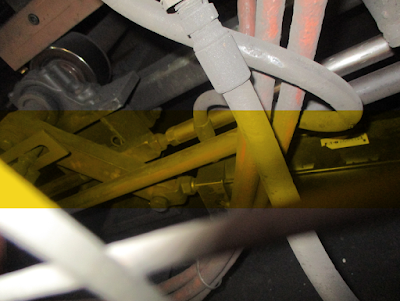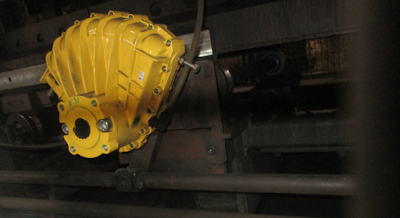The Kinetrol rotary vane design is based upon a single moving part which eliminates additional parts required to convert linear motion to rotary motion. This simple and innovative design provides a highly accurate and extremely reliable actuator for operating valves, drives and dampers, and is perfectly suited for the most demanding process control applications. For more information visit www.kinetrolusa.com or call 972-447-9443.
Electropneumatic Valve Positioner Offering Precise Control, Smooth Operation, and Fast Response
 |
| Features of the Kinetrol EL positioner (click on image for larger view). |
The Kinetrol EL is one of the valve automation industries best performing electro-pneumatic positioners available. It combines the precision and adaptability of a digital electronic control circuit with the smoothness and efficiency of Kinetrol's proven proportional servo valve, to give the best available 4-20mA positioning performance from rotary pneumatic actuators.
To compliment this unbeatable performance, the EL combines the easiest available setup procedure, easiest access to all functions and options, easy connectivity, and a compact all-metal housing, unique easy-set isolated angle retransmit, and limit switch options inside the same enclosure.
The EL positioner is designed to smoothly and precisely drive a rotary or linear actuator to a position set by the 4-20 mA input signal, and then accurately hold it there until the signal changes.
Inside the EL, a microprocessor in the loop powered 4-20 mA positioner circuit reads signal via one channel of a 12-bit A-D convertor, reads the position voltage from tie pot via the second channel of the A-D convertor, and compares the two. If an error between desired position and actual position exists, the EL changes it's output to the servo valve in order to drive the actuator in the direction required to eliminate the error.
In sync with the movement of the actuator, the feedback pot voltage changes, and the microprocessor continually calculates how to adjust the servo valve in order to guide the actuator accurately into position. Because the servo valve is a fully proportional device, it can be adjusted precisely and smoothly to slow the actuator to a stop exactly at the required position. Programmed in the microprocessor is an advanced algorithm that allows this critical dynamic valve adjustment to be made correctly, giving optimal results with any actuator/load combination. Slow or fast responding, high friction or low friction, high inertia or low inertia, all can be optimized by PGAIN and DAMP parameters via the positioner circuit pushbuttons. The 12-bit A-D conversion gives the amazing resolution of approximately 1/40 of a degree angular.
For more information, contact Kinetrol USA by calling 972-447-9443 or visit their web site at https://kinetrolusa.com.
Oil Refinery Chooses Kinetrol for Fast Closing 6" Ball Valve
 |
| 6" ball valve with failing actuator. |
 |
| The specified Kinetrol actuator and high Cv solenoid valve. |
After calculating the air flow characteristics of the actuator and the response time of the spring, they knew the critical element was finding a high flow capacity solenoid valve. It needed to be capable of dumping the actuator air quickly enough to close the actuator in under 1 second.
The result was a recommendation to use a Kinetrol model 147-120-4900L spring return actuator with a third party, high Cv (9.7), solenoid valve.
Once installed the 6" ball valve and Kinetrol assembly worked perfectly and, at the time of this writing, has been in service for 3.5 years, operating with no downtime and maintaining the under 1 second closing requirement.
For more information, contact Kinetrol USA. Call 972-447-9443 or visit https://kinetrolusa.com.
The Top Five Reasons Why Kinetrol is a Better Choice Than Rack and Pinion Actuators

1. Rotary vane actuators do not convert linear motion to rotary motion, unlike rack and pinion actuators.
No additional gearing is required and no side loading is transferred to the actuator housing.
2. Vane actuator lip seals are the key for long life.
The double opposing lip seal design, with stainless steel expanders, provides unmatched service life by using air pressure to improve the actuators seal-to-enclosure contact, and provide a “self cleaning” effect on the epoxy or PTFE internal finish.3. The elimination of pressure bearing o-ring shaft seals.
Rack and pinion actuators require shaft sealing o-rings that are exposed to the full supply air pressure used to operate the actuator. These o-rings wear, causing leaks, a drop in efficiency, and wasted energy through air consumption. Vane actuators' double opposing lip seals isolate the supply air pressure from the actuator shaft, requiring only a low friction bearing on the shaft.4. Rotary vane actuators provide superior modulating accuracy.
Because of the integral vane and shaft (machine from a single casting), lost motion or hysteresis is reduced dramatically which intern provides much tighter modulation and control. The vane actuators inherent low friction also reduces hunting and sticking.5. Rotary vane actuator spring return units are designed to be virtually indestructible.
Using low stress, clock springs reduces spring tension loss and metal fatigue. The housing for vane a actuator springs are sealed from the atmosphere, preventing corrosion of internal parts. Most importantly, these type of spring units provide the lowest torque loss which enables the section of smaller (less expensive) actuators.Kinetrol USA
https://kinetrolusa.com
972-447-9443
Kinetrol Blueline Pneumatic Actuators for Foodservice Applications
"Blueline" series of pneumatic vane actuators from Kinetrol are designed for use in food service and beverage processing. The actuators are intended to be installed in areas requiring harsh chemical washing-down. These areas are very tough on most pneumatic actuator types because the actuator is very often adversely affected by the caustic or acidic chemicals used in cleaning.
The Kinetrol Blueline actuator has an applied coating that meets the FDA allowance whereby "Resinous and polymeric coatings may be safely used as the food-contact surface of articles intended for use in producing, manufacturing, packing, processing, preparing, treating, packaging, transporting, or holding food ...".
Kinetrol's rotary design is based upon a single moving part which eliminates additional parts required to convert linear motion to rotary motion. This simple and innovative design provides a highly accurate and extremely reliable actuator for operating foodservice and beverage industry valves, providing outstanding cycle life, smooth and precise movement.
Kinetrol's Blueline Series offers a very economical option for use in foodservice wash-down environments and are in compliance with the Federal Food, Drug and Cosmetic Act (FDA) regulations, including 21 CR 175.300 (Code of Federal Regulations). The combination of Kinetrol's superior actuator design, coupled with the wash-down approved coating, makes a very compelling case to specify the Blueline actuator for your next food and beverage industry actuation requirement.
For more information, contact:
Kinetrol USA
https://kinetrolusa.com
972-447-9443
How To Install and Remove a Kinetrol Actuator Spring Unit
This video demonstrates how to install and removed a spring unit for a Kinetrol vane actuator. Spring units are available for either clockwise or counter clockwise spring action. They are mounted, as standard, between the actuator and what it drives. With spring units alone, direction is determined by looking at the unit from the end which interfaces with the actuator.
Kinetrol Actuator in 60 Deg. Rotation, Continuous Cycling Application on Permanent Mold Casting Machine
 |
| Hydraulic cylinder (shaded in yellow) and it's associated rods and yokes. Note the difficult access and adjustability. |
- No waste from the mold
- Reusable mold
- Good surface finish
- Good dimensional accuracy
- High production rates
- Higher conductivity levels
 |
| Kinetrol actuator replacement. The actuator mounts directly to equipment, connected directly to the shaft eliminating the need for rods and yokes. |
The local Kinetrol Distributor was called in and immediately saw the opportunity to replace the hydraulic cylinder, rods, and scotch-yokes with a Kinetrol actuator and simple mounting.
The Kinetrol actuators have been working for several years now, moving continuously without problem and eliminating the need for frequent adjustments.
For more information, contact:
Kinetrol USA
https://kinetrolusa.com
972-447-9443
Subscribe to:
Posts (Atom)
